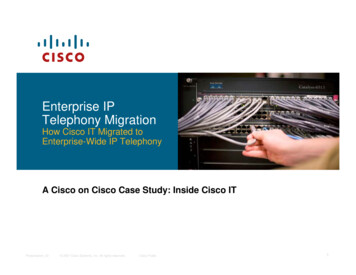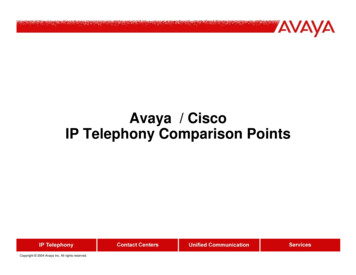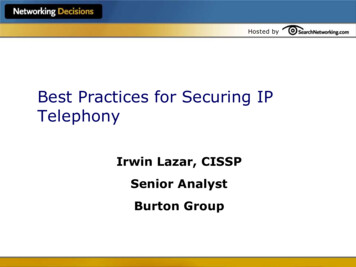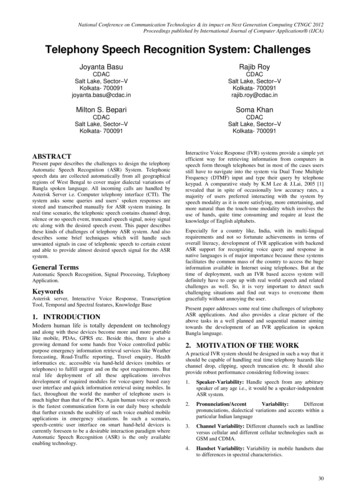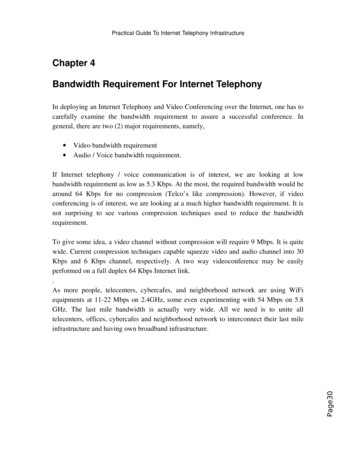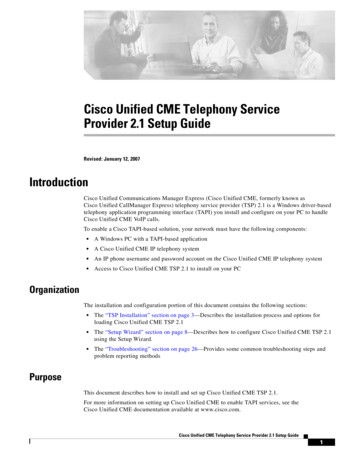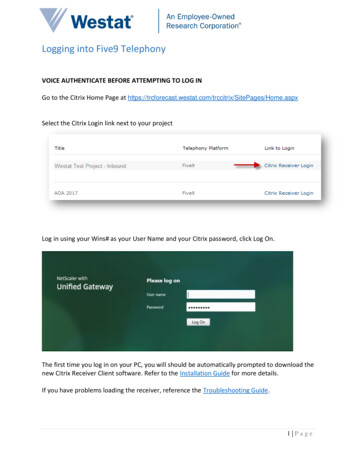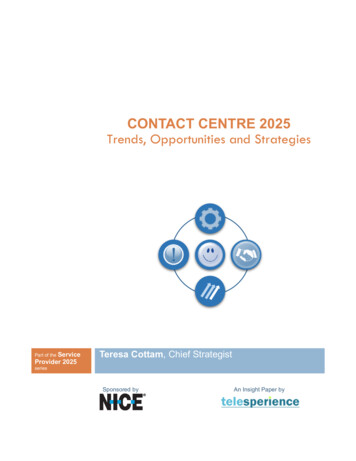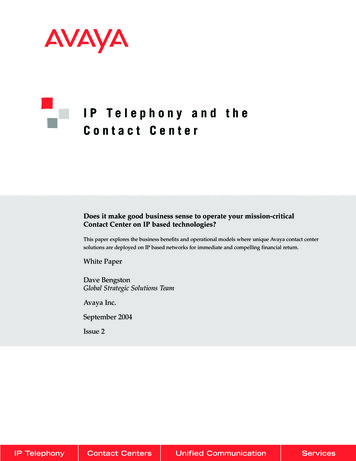
Transcription
IP Telephony and theContact CenterDoes it make good business sense to operate your mission-criticalContact Center on IP based technologies?This paper explores the business benefits and operational models where unique Avaya contact centersolutions are deployed on IP based networks for immediate and compelling financial return.White PaperDave BengstonGlobal Strategic Solutions TeamAvaya Inc.September 2004Issue 2IP TelephonyContact CentersUnified CommunicationServices
Ta b l e o f C o n t e n t sSection 1: Overview . . . . . . . . . . . . . . . . . . . . . . . . . . . . . . . . . . . . . . . . . . . . . 1Section 2: Basic Components in an Avaya IP Contact Center . . . . . . . . . . . . . . . . . . . . . . . 2Section 3: Voice Server Consolidation . . . . . . . . . . . . . . . . . . . . . . . . . . . . . . . . . . . 3Section 4: “Virtual” Site Consolidation . . . . . . . . . . . . . . . . . . . . . . . . . . . . . . . . . . . 8Section 4.1: Virtual Operations and the Branch Office. . . . . . . . . . . . . . . . . . . . . . . 10Section 5: Enterprise Resource Optimization . . . . . . . . . . . . . . . . . . . . . . . . . . . . . . . . 11Section 6: Contact Center Globalization . . . . . . . . . . . . . . . . . . . . . . . . . . . . . . . . . . 13Section 6.1: Option #1 — IP Endpoints . . . . . . . . . . . . . . . . . . . . . . . . . . . . . . . 14Section 6.2: Option #2 — Remote Gateways . . . . . . . . . . . . . . . . . . . . . . . . . . . . 15Section 6.3: Option #3 — Peer-to-Peer . . . . . . . . . . . . . . . . . . . . . . . . . . . . . . . 16Section 7: The Total Business Case for IP Contact Centers . . . . . . . . . . . . . . . . . . . . . . . . 20Section 8: Conclusion . . . . . . . . . . . . . . . . . . . . . . . . . . . . . . . . . . . . . . . . . . . . 20
Section 1: OverviewOver the past three years, there has been an explosion in the amount of information available on Voice over IP(VoIP) and IP (Internet Protocol) Telephony. This information has largely been focused on answering the questions“What is VoIP and IP telephony?” and “How does VoIP and IP Telephony work?” As potential users of thetechnology have become more comfortable with the answers to those two infrastructure related questions, the keyquestion now becomes “Why should I use VoIP and IP Telephony?” The purpose of this paper is to answer themore specific question, “Why should I use VoIP and IP telephony in the contact center?”This paper assumes that the reader has some fundamental understanding of VoIP and IP Telephonytechnology basics. For the purpose of this discussion, VoIP is the transmission of voice conversations overan IP based data network and represents an alternative transport method to the more traditional TimeDivision Multiplexing (TDM) or circuit switching. IP Telephony is the collective set of software based voiceapplications that transport voice via VoIP.Avaya offers unique and compelling applications of IP Telephony in the contact center. The compellingvalue of IP Telephony is not just about creating converged networks, toll (long-distance) call avoidance, andsimpler Moves, Adds, and Changes (MACs). The significant business value is in a continuum of contactcenter solutions that include: Voice Server Consolidation reduces capital expenditures by 30-35% and ongoing maintenance andsupport by 12-15% by radically reducing application and application infrastructure complexity1. Thisreduction in complexity makes the contact center more agile when responding to changes in thecompetitive landscape. Virtual Site Consolidation increases staffing efficiencies in the range of 3-8% by pooling agent resourcesacross the enterprise1. Enterprise Resource Optimization cuts staffing costs by 3-9%, helps grow revenue, or increases customerloyalty by connecting the right agent to the right caller at the right time1. Contact Center Globalization delivers operating cost reductions of approximately 30% by staffing thecontact centers with high quality, low turnover, college-educated agents from developing economies1.All of these solutions cost justify themselves in standalone implementations. However, the true power toalter business fundamentals is unleashed when these solutions are deployed in combination across thesolution continuum. Avaya IP contact centers exhibit the following technological differentiators:1Results are highly dependent on individual operating environments. Obviously, different implementation methodologies, processes,and objectives may contribute to lower or higher results.1a higher planeof communication
Massive scalability Granular reporting detail Higher throughput from increased agent occupancy Dynamic resizing of agent pools to meet service levels Matching the right caller to the right agent at the right cost Equitable distribution of work across the enterprise Global deployments The ability to deploy in 100% IP, 100% circuit switched, or any mix of IP and circuit switchedenvironmentsBefore examining each of these solutions and technology areas in detail, let’s look at some fundamentalcomponents in an Avaya IP contact center.Section 2: Basic Components in an Avaya IP Contact CenterThe fundamental components in an Avaya based IP Contact Center include Avaya CommunicationManager Software, Avaya Media Servers, Avaya Media Gateways, and Endpoints. These components arealso requirements in other IP-based communications applications such as call coverage, call forwarding andmessaging for administrative knowledge workers. Avaya Communication Manager Software provides the core intelligence of the contact center system.It is also provides the administrative PBX capabilities — including roughly 700 distinct features— as standard in the same globally available software. The application includes conditional routing(Vectoring), skills based routing (Expert Agent Selection), agent work states (Login, Logout, AfterCall Work, and Auxiliary Work), advanced agent and work selection (Business Advocate/DynamicAdvocate), and Computer Telephony Integration Application Programming Interfaces such as ASAI(Applications Switch Adjunct Interface), as well as management of announcements, integratedprompting, and queue treatments. This communications software also provides the VoIP gatekeeperfunctions of registration, admission, and status. Media Servers execute the IP Telephony application software. Avaya offers a variety of server operatingsystem options, including Windows 2000, Linux, and Unix. Hardware options include traditionaltelephony cards (DEFINITY ), internal blade servers (Avaya S8100 and Avaya S8300), and rackmounted Intel based servers (Avaya S8500 and Avaya S8700) to meet your unique business needs.2a higher planeof communication
Media Gateways convert circuit switched voice calls to IP media streams in a gateway. Avaya Gatewayscan be traditional Avaya DEFINITY cabinets, or rack mounted data type devices such as the AvayaG350, Avaya G650 and Avaya G700 gateways. Gateways communicate with the media servers usingthe ITU H.248 standard. Endpoints are either IP based telephones or IP based softphones (PC based software telephonyapplication). In remote agent applications, IP endpoints either work as standalone devices or inconjunction with a media gateway. Wireless IP phones as well as an IP based softphone for WindowsCE based Pocket PCs are also options. All IP endpoints currently conform to the ITU H.323 standard;Session Initiation Protocol (SIP) is also supported. For more traditional deployments, circuit switchedanalog, digital, and ISDN -BRI telephones are also fully supported.The four components listed above are used in all contact center implementations. Additional supportingapplications typically include an Avaya Call Management System (CMS) for advanced contact centerreporting, Avaya Interaction Center for Computer Telephony Integration (CTI) functionality (i.e. desktoptelephony, screen pops, data directed routing) and multimedia routing (email, fax, text chat, and webcollaboration), Avaya Predictive Dialing System (outbound contact), Avaya Interactive Response (IVRself service), as well as Avaya Quality Management (interaction recording and evaluation packages) andAvaya Workforce Management (forecasting and agent work scheduling) systems. Avaya CommunicationManager software, media servers, gateways, and endpoints serve as the core building blocks in all AvayaIP contact center solutions. The following sections examine the typical drivers for Avaya IP contact centerdeployment: Voice Server Consolidation, Virtual Site Consolidation, Enterprise Resource Optimization, andContact Center Globalization.Section 3: Voice Server ConsolidationFor a new multi-site contact center deployment, the ability for Avaya to consolidate voice servers may reducecapital expenditures in the range of 30-35% and lower ongoing support costs in the range of 12-15%1. Thebiggest cost reductions provided by IP telephony come from simplifying the applications and applicationinfrastructure. By comparison, the cost savings from operating a converged network are relatively minor.Through the 1990’s and into the year 2000, Information Technology (IT) organizations struggled to keep upwith the breakneck growth of their organizations. Many applications were deployed haphazardly and suboptimally in order to meet the immediate business needs of fast growing enterprises. In some cases, theywere cobbled together during mergers or acquisitions, in other cases, the applications were rushed to becomeY2K compliant. Since the global economic slowdown began in the spring of 2001, technical organizations3a higher planeof communication
have undertaken the optimization of existing applications and application infrastructure to help reducethe total cost of ownership (TCO). One of the significant trends in this rework and optimization is serverconsolidation. In fact, over the past two years, server consolidation has ranked as one of the top five ITinitiatives of the typical Fortune 500 firm. Consolidation of voice servers is part of that trend. In the contactcenter, voice servers include, but are not limited to, the combination of software and hardware in applicationssuch as ACD/PBXs, Desktop and Network Routing based Computer Telephony Integration, Interactive VoiceResponse Units, Predictive Dialing Systems, Voice Mail Systems, Reporting Systems, Quality ManagementSystems, and Workforce Management Systems. VoIP enables the consolidation of voice servers in a multisite contact center environment. By taking advantage of the ubiquity of low cost, high performance, IP basedWide Area Networks (WANs), applications are deployed with simplicity throughout the enterprise. Themantra of IP telephony might well be “Deploy Once, Extend Everywhere”.The simpler application infrastructure enables the contact center IT support staff to react to changingbusiness needs with increased speed and flexibility; cycle times for mass system administration changesnow take hours instead of weeks. As a result, the contact center is now more agile and opportunistic, andan asset instead of a hindrance when executing on strategic intent. The following sections illustrate thebenefits of voice server consolidation with an example.ProblemAn enterprise with five contact centers is operating each location independently. Each location has its owncontact center management and technology management team. At each site, there is a physical installationof an Automatic Call Distributor/Private Branch Exchange (ACD/PBX) Server, Reporting Server, QualityManagement (call recording and evaluation application), Workforce Management System (WFMS), DesktopComputer Telephony Integration (CTI), Interactive Voice Response (IVR) system with a standalone Speechserver, and a Voice Mail system. These applications are coming off of their existing leases, and managementwants to evaluate new technology alternatives. This deployment is depicted in Diagram 1.4a higher planeof communication
Diagram 1: Traditional TDM based multi-site contact center deploymentManagement realizes that the existing operating and technology model has some serious serverredundancy and operating inefficiencies. The redundant investments include: Software applications Hardware servers Supporting software (operating systems, database management systems, Web servers, etc) System interfaces between applications Data centers (physical security, cooling, power and fire suppression systems) Redundant serviceactivities at each server location include: Installation System integration Configuration Administration Maintenance5a higher planeof communication
Because of the numerous sites, it was very easy for each location to be on different software loads, patches,and security fixes. These system inconsistencies led to functional, process, and operational defects, which inturn led to devaluing of the corporate brand and customer defections. The complexity of the infrastructurerequired three weeks of lead-time to make relatively simple changes such as adding a toll free number, oradding a skill group. Each location needed its own highly qualified support staff to keep the infrastructurerunning at peak performance. Finally, the ability to plan and execute on a business continuity plan waslimited by the lack of per site consistency.SolutionAvaya Communication Manager helped to alleviate the infrastructure redundancies and operatinginefficiencies by enabling a contact center utility. This utility is very similar in concept to the ApplicationService Provider (ASP) model. Once a single instance of Avaya applications are deployed, the ubiquity ofIP based Wide Area Networks (WANs) extend the contact center functionality to any location, whetheracross town or across the globe. This simplified infrastructure lets the support staff make enterprise widesystem changes in minutes as opposed to weeks. More importantly, this consolidation effort makes it easierto ensure that consistent service is delivered. The contact center now gets extended through remote IPtelephones (physical telephone sets or PC based softphones), remote gateways, or a combination of both.Remote IP phones fit nicely with branch offices, small offices, home office workers, and telecommuters,while the remote gateway options work in scenarios where remote public switched telephone system(PSTN) access is desired (for local presence as well as diversified access). In an Avaya IP contact center,these remote gateways can become standalone voice servers in the event of WAN failure. This modelconcentrates the application infrastructure and a vast majority of the support staff in a single corporate datacenter location. For our five-site example, these concepts are illustrated in Diagram 2.6a higher planeof communication
Diagram 2: IP based multi-site contact center: “Deploy Once — Extend Everywhere”From a technology management perspective, the primary value of IP telephony comes from consolidatingthe application infrastructure, centralizing contact center application support staff, and simplifyingthe geographic reach of application logic in multi-site environments. Comparatively, the benefits frommanaging a converged network could be relatively small.A unique Avaya differentiator is the ability to operate an IP based contact center at massive scalewith consolidated voice servers. As proof points, Avaya is currently supporting global contact centerdeployments where more than 2,000 agents are operating on a single instance of Avaya CommunicationManager software. A single Avaya S8700 Media Server has the ability to support 5,200 active agents.Voice server consolidation is not about just replacing a lot of small PBXs or ACDs with larger PBXs orACDs. Server consolidation is about:7a higher planeof communication
Serving customers better Capturing market share Increasing revenue Reducing costsMost importantly, consolidation is about redesigning your network to establish a foundation for the rapiddeployment of new strategic initiatives. Virtual site consolidation should be considered one of thosestrategic initiatives.Section 4: “Virtual” Site ConsolidationThe ability for Avaya to implement virtual site consolidation through IP contact center technologies mayreduce agent staffing levels 4% to 8% for a given service level1. In the past, the main enabler for contact centervirtualization was a horrifically complex, very expensive, nearly unsupportable, Signaling System 7 (SS7)and Computer Telephony Integration (CTI) based carrier routing application. Because of the complexity, itis fairly common for firms to out-task this CTI alternative. Avaya Communication Manager significantlyreduces this multi-site complexity through the extension of superior contact center logic over simple, lowcost, and ubiquitous IP networks. With “virtual” site consolidation, contact center agents may work in anynumber of sites globally — including regional centers, branch offices, small offices, or home offices — and theentire agent population can be managed as a single talent pool by a single instance of Avaya CommunicationManager software. A well-known fact of call center management is that a single large call center runs muchmore efficiently from a staffing perspective than several smaller centers — a very straightforward applicationof Erlanger C principles. For a given service level, a single pool of agents is more efficient than several smallergroups, and the larger the agent pool, the higher the agent occupancy level.Continuing with our five-site example from the previous section, let’s assume that the same type of work isperformed in each center. Approximately 500 calls per half hour are distributed to each center, the averagetalk time is four minutes, and after call work time is 45 seconds per call (thus making the average handletime equate to 285 seconds). In order to meet a service level of answering 90% of calls in 30 seconds, eachstandalone center needs 88 agents staffed during the thirty-minute period, and agents are occupied withwork 90% of the time during that interval (from Erlanger C tables). A total of 440 total agents (88 agents x5 sites) are needed to meet the service level set by senior management and expected by callers. If all fivephysical locations are managed as a single agent pool, the staffing situation improves significantly. Withthe same traffic levels and call handling assumptions, this enterprise now requires only 409 agents to meet8a higher planeof communication
the same service level of 90% of calls answered in 30 seconds. The additional staffing efficiency comes froma higher level of agent occupancy: the pooled agents are occupied with work 97% of the time during theinterval as compared with 90% occupancy with the 5 separately served contact. Assuming no reductionin call volume, the agent salary savings of 31 people is saved into perpetuity. The supporting technologyresources also gain efficiencies with the single virtual center. Trunking, IVR system ports, and QualityManagement system ports all show efficiency gains in the pooled center. Under the standalone scenario,84 trunks are required for each individual center (derived from Erlanger B tables); a total of 420 trunks (84x 5) are required to support the needs of the five-standalone centers. However, when pooled into a singlevirtual center, only 370 trunks are needed. The efficiencies from the pooling principal save the cost of 50trunks into perpetuity. IVR and Quality Management system ports also show similar efficiency gains.Management’s ability to plan and adjust to changes in their operating environment also improves. By usingthe Avaya Call Management System (CMS), all contact center activities across all sites are collapsed intoa single database application, giving consolidated views of call center performance with a wide varietyof standard real-time, historical and integrated (combined real-time and historical) reports that can beeasily customize
reporting, Avaya Interaction Center for Computer Telephony Integration (CTI) functionality (i.e. desktop telephony, screen pops, data directed routing) and multimedia routing (email, fax, text chat, and web collaboration), Avaya Predictive Dialing System (outbound c

